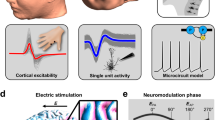Abstract
Inducing a switch in neuronal state using energy optimal stimuli is relevant to a variety of problems in neuroscience. Analytical techniques from optimal control theory can identify such stimuli; however, solutions to the optimization problem using indirect variational approaches can be elusive in models that describe neuronal behavior. Here we develop and apply a direct gradient-based optimization algorithm to find stimulus waveforms that elicit a change in neuronal state while minimizing energy usage. We analyze standard models of neuronal behavior, the Hodgkin-Huxley and FitzHugh-Nagumo models, to show that the gradient-based algorithm: 1) enables automated exploration of a wide solution space, using stochastically generated initial waveforms that converge to multiple locally optimal solutions; and 2) finds optimal stimulus waveforms that achieve a physiological outcome condition, without a priori knowledge of the optimal terminal condition of all state variables. Analysis of biological systems using stochastically-seeded gradient methods can reveal salient dynamical mechanisms underlying the optimal control of system behavior. The gradient algorithm may also have practical applications in future work, for example, finding energy optimal waveforms for therapeutic neural stimulation that minimizes power usage and diminishes off-target effects and damage to neighboring tissue.












Similar content being viewed by others
References
Aghababa, M. P., Amrollahi, M. H., & Borjkhani, M. (2012). Application of GA, PSO, and ACO algorithms to path planning of autonomous underwater vehicles. Journal of Marine Science and Application, 11(3), 378–386.
Aliev, R. R., & Panfilov, A. V. (1996). A simple two-variable model of cardiac excitation. Chaos, Solitons & Fractals, 7(3), 293–301.
Alle, H., Roth, A., & Geiger, J. R. P. (2009). Energy-efficient action potentials in hippocampal mossy fibers. Science, 325, 1405–1408.
Alon, U. (2006). An introduction to systems biology - design principles of biological circuits. Boca Raton: CRC Press, Taylor & Francis Group, LLC.
Attwell, D., & Laughlin, S. B. (2001). An energy budget for signaling in the grey matter of the brain. Journal of Cerebral Blood Flow and Metabolism, 21(10), 1133–45.
Barnett, W., O’Brien, G., & Cymbalyuk, G. (2013). Bistability of silence and seizure-like bursting. Journal of Neuroscience Methods, 220(2), 179–89.
Betts, J. J. T. (1998). Survey of numerical methods for trajectory optimization. Journal of Guidance, Control, and Dynamics, 21(2), 193–207.
Bryson, A. E., & Ho, Y.-C. (1975). Applied Optimal Control (Revised Pr.). Hemisphere Publishing Corporation.
Butera, R. J., Rinzel, J., & Smith, J. C. (1999). Models of respiratory rhythm generation in the pre-Bötzinger complex. I. Bursting pacemaker neurons. Journal of Neurophysiology, 82(1), 382–97.
Chen, Y., Wang, J., Wei, X., Deng, B., & Che, Y. (2011). Particle swarm optimization of periodic deep brain stimulation waveforms. Proceedings of the 30th Chinese Control Conference, 754–757.
Clay, J. R., Paydarfar, D., & Forger, D. B. (2008). A simple modification of the Hodgkin and Huxley equations explains type 3 excitability in squid giant axons. Journal of the Royal Society Interface, 5, 1421–1428.
Clay, J. R., Forger, D., & Paydarfar, D. (2012). Ionic mechanism underlying optimal stimuli for neuronal excitation: role of Na + channel inactivation. PLoS One, 7(9), e45983.
Danzl, P., Nabi, A., & Moehlis, J. (2010). Charge-balanced spike timing control for phase models of spiking neurons. Discrete and Continuous Dynamical Systems, 28(4), 1413–1435.
Dean, D. A., Forger, D. B., & Klerman, E. B. (2009). Taking the lag out of jet lag through model-based schedule design. PLoS Computational Biology, 5(6), e1000418.
Doležal, J. (1978). A gradient-type algorithm for the numerical solution of two-player zero-sum differential game problems. Kybernetika, 14(6), 429–446.
Durand, D. M., & Warman, E. N. (1994). Desynchronization of epileptiform activity by extracellular current pulses in rat hippocampal slices. Journal of Physiology, 480(3), 527–537.
Feng, X., Greenwald, B., & Rabitz, H. (2007). Toward closed-loop optimization of deep brain stimulation for Parkinson’s disease: concepts and lessons from a computational model. Journal of Neural Engineering, 4(2), L14–L21.
FitzHugh, R. (1961). Impulses and physiological states in theoretical models of nerve membrane. Biophysical Journal, 1, 445–466.
Forger, D. B., & Paydarfar, D. (2004). Starting, stopping, and resetting biological oscillators: in search of optimum perturbations. Journal of Theoretical Biology, 230, 521–532.
Forger, D. B., Paydarfar, D., & Clay, J. R. (2011). Optimal stimulus shapes for neuronal excitation. PLoS Computational Biology, 7(7), e1002089.
Gelfand IM & Fomin SV (2000). Calculus of Variations. Courier Dover Publications
Glass, L. (2001). Synchronization and rhythmic processes in physiology. Nature, 410(6825), 277–284.
Golfetto, W. A., Fernandes, S., & da, S. (2012). A review of gradient algorithms for numerical computation of optimal trajectories. Journal of Aerospace Technology and Management, 4(2), 131–143.
Gupta, N., & Rink, R. (1973). Optimum control of epidemics. Mathematical Biosciences, 18, 383–396.
Hauptmann, C., Popovych, O., & Tass, P. A. (2005). Effectively desynchronizing deep brain stimulation based on a coordinated delayed feedback stimulation via several sites: a computational study. Biological Cybernetics, 93(6), 463–470.
Hodgkin, A. L., & Huxley, A. F. (1952). A quantitative description of membrane current and its application to conduction and excitation in nerve. Journal of Physiology, 117(4), 500–544.
Howalski, C. H., da Silva, G. A., Poppi, R. J., Godoy, H. T., & Augusto, F. (2007). Neuro-genetic multioptimization of the determination of polychlorinated biphenyl congeners in human milk by headspace solid phase microextraction coupled to gas chromatography with electron capture detection. Analytica Chimica Acta, 585, 66–75.
Iasemidis, L. D. (2003). Epileptic seizure prediction and control. IEEE Transactions on Biomedical Engineering, 50(5), 549–558.
Izhikevich, E. M. (2000). Neural excitability, spiking and bursting. International Journal of Bifurcation and Chaos, 10(6), 1171–1266.
Izhikevich EM (2007). Dynamical systems in neuroscience: the geometry of excitability and bursting. (TJ Sejnowski & TA Poggio, Eds.). Cambridge, Massachusetts: MIT Press
Jezernik, S., & Morari, M. (2005). Energy-optimal electrical excitation of nerve fibers. IEEE Transactions on Biomedical Engineering, 52(4), 740–743.
Joshi, H. R. (2002). Optimal control of an HIV immunology model. Optimal Control Applications and Methods, 23(4), 199–213.
Kawato, M., & Suzuki, R. (1980). Two coupled neural oscillators as a model of the circadian pacemaker. Journal of Theoretical Biology, 86(3), 547–575.
Kelley, H. J. (1962). Methods of Gradients. In G. Leitmann (Ed.), Optimization Techniques (5th ed., pp. 206–254). New York: Academic Press, Inc.
Kepler, T. B., & Perelson, a. S. (1993). Somatic hypermutation in B cells: an optimal control treatment. Journal of Theoretical Biology, 164(1), 37–64.
Kirschner, D., Lenhart, S., & Serbin, S. (1997). Optimal control of the chemotherapy of HIV. Journal of Mathematical Biology, 35(7), 775–792.
Koelling, M. E., & Nykamp, D. Q. (2012). Searching for optimal stimuli: ascending a neuron’s response function. Journal of Computational Neuroscience, 33(3), 449–473.
Lee, E. S. (1964). Optimization by a gradient technique. Industrial & Engineering Chemistry Fundamentals, 3(4), 373–380.
Lian, J., Bikson, M., Sciortino, C., Stacey, W. C., & Durand, D. M. (2003). Local suppression of epileptiform activity by electrical stimulation in rat hippocampus in vitro. Journal of Physiology, 547(2), 427–434.
Loddenkemper, T., & Pan, A. (2001). Deep brain stimulation in epilepsy. Journal of Clinical Neurophysiology, 116(6), 217–34.
Lozano, A. M. (2010). Deep brain stimulation for Parkinson’s disease. Journal of Neurosurgery, 112(3), 199–203.
Machens, C. K., Gollisch, T., Kolesnikova, O., & Herz, A. V. M. (2005). Testing the efficiency of sensory coding with optimal stimulus ensembles. Neuron, 47(3), 447–456.
Moehlis, J., Shea-Brown, E., & Rabitz, H. (2006). Optimal inputs for phase models of spiking neurons. Journal of Computational and Nonlinear Dynamics, 1(4), 358–367.
Nabi, A., & Moehlis, J. (2012). Time optimal control of spiking neurons. Journal of Mathematical Biology, 64(6), 981–1004.
Nagumo, J., Arimoto, S., & Yoshizawa, S. (1962). An active pulse transmission line simulating nerve axon. Proceedings of the IRE, 2061–2070.
Offner, F. (1946). Stimulation with minimum power. Journal of Neurophysiology, 9(5), 387–390.
Osborne, M. R. (1969). On shooting methods for boundary value problems. Journal of Mathematical Analysis and Applications, 27, 417–433.
Paydarfar, D., & Buerkel, D. D. (1995). Dysrhythmias of the respiratory oscillator. Chaos, 5(1), 18–29.
Paydarfar, D., Forger, D. B., & Clay, J. R. (2006). Noisy inputs and the induction of on-off switching behavior in a neuronal pacemaker. Journal of Neurophysiology, 96(6), 3338–48.
Raivo, T. (2000). Computational Methods for Dynamic Optimization and Pursuit-Evasion Games. Helsinki University of Technology.
Rao, A. (2010). A survey of numerical methods for optimal control. Advances in the Astronautical Sciences, 135, 497–528.
Rinzel, J., & Ermentrout, G. B. (1998). Analysis of neural excitability and oscillations. In Methods in Neuronal Modeling (2nd ed., pp. 251–292).
Rubin, J. E., & Terman, D. (2004). High frequency stimulation of the subthalamic nucleus eliminates pathological thalamic rhythmicity in a computational model. Journal of Computational Neuroscience, 16(3), 211–235.
Schiff, S. J. (2010). Towards model-based control of Parkinson’s disease. Philosophical Transactions of the Royal Society A, 368, 2269–2308.
Sengupta, B., Stemmler, M., Laughlin, S. B., & Niven, J. E. (2010). Action potential energy efficiency varies among neuron types in vertebrates and invertebrates. PLoS Computational Biology, 6(7), e1000840.
Serkh, K., & Forger, D. B. (2014). Optimal schedules of light exposure for rapidly correcting circadian misalignment. PLoS Computational Biology, 10(4), e1003523.
Sunderam, S., Gluckman, B., Reato, D., & Bikson, M. (2010). Toward rational design of electrical stimulation strategies for epilepsy control. Epilepsy & Behavior, 17(1), 6–22.
Tahayori, B., & Dokos, S. (2012). Optimal stimulus current waveshape for a Hodgkin-Huxley model neuron. 34th Annual International Conference of the IEEE EBS, 4627–4630.
Tass, P. A. (2003). A model of desynchronizing deep brain stimulation with a demand-controlled coordinated reset of neural subpopulations. Biological Cybernetics, 89(2), 81–88.
Torrealdea, F. F., D’Anjou, A., Graña, M., Sarasola, C., & D’Anjou, A. (2006). Energy aspects of the synchronization of model neurons. Physical Review E, 74(1), 011905.
Watson, A., Barlow, H., & Robson, J. (1983). What does the eye see best? Nature, 302(5907), 419–422.
Winfree, A. T. (2001). The Geometry of Biological Time. (J. E. Marsden, L. Sirovich, & S. Wiggins, Eds.) (2nd ed.). New York: Springer.
Ypma, T. J. (1995). Historical development of the Newton–Raphson method. SIAM Review, 37(4), 531–551.
Acknowledgments
We thank Daniel Forger and Kirill Serkh for discussions on boundary value problems and also introducing us to the gradient algorithm. We thank John Clay for discussions regarding the ionic basis for excitability in squid axons, and Premananda Indic for discussions and guidance regarding gradient analysis. We also thank William Schwartz and anonymous reviewers for their suggestions and feedback on our manuscript. This work was supported by NIH R01 GM104987 and the Wyss Institute of Biologically Inspired Engineering. The funders had no role in study design, data collection and analysis, decision to publish, or preparation of the manuscript.
Conflict of interest
The authors declare that they have no conflict of interest.
Author information
Authors and Affiliations
Corresponding author
Additional information
Action Editor: J. Rinzel
Electronic supplementary material
Below is the link to the electronic supplementary material.
OR 1
Mathematical foundations of the gradient algorithm. A systematic tutorial in the mathematics underlying the gradient algorithm that we present in this paper. (PDF 90 kb)
OR 2
Implementation of gradient algorithm for the Hodgkin-Huxley and the Fitzhugh-Nagumo models. We show the matrices and equations used in the application of the gradient algorithm to the two models in this paper. (PDF 49 kb)
Rights and permissions
About this article
Cite this article
Chang, J., Paydarfar, D. Switching neuronal state: optimal stimuli revealed using a stochastically-seeded gradient algorithm. J Comput Neurosci 37, 569–582 (2014). https://doi.org/10.1007/s10827-014-0525-5
Received:
Revised:
Accepted:
Published:
Issue Date:
DOI: https://doi.org/10.1007/s10827-014-0525-5




